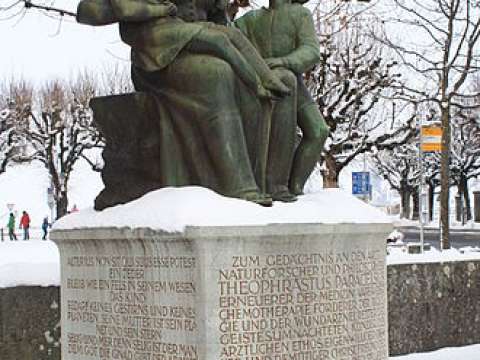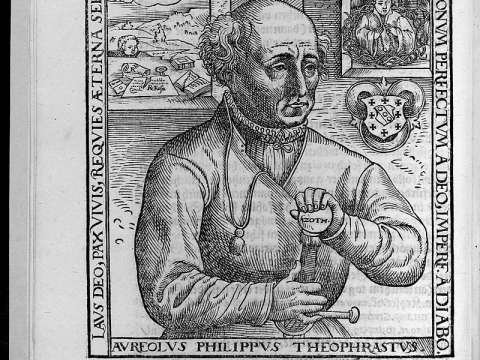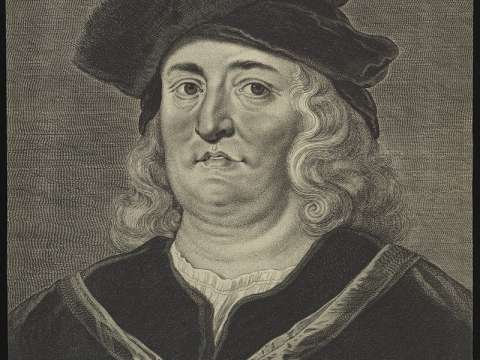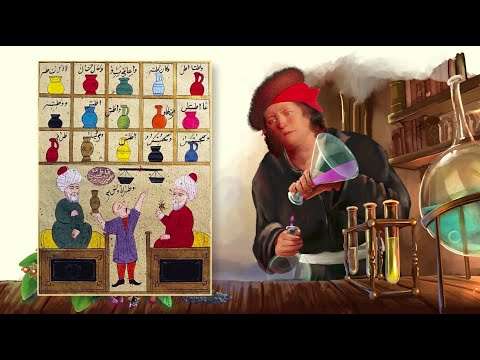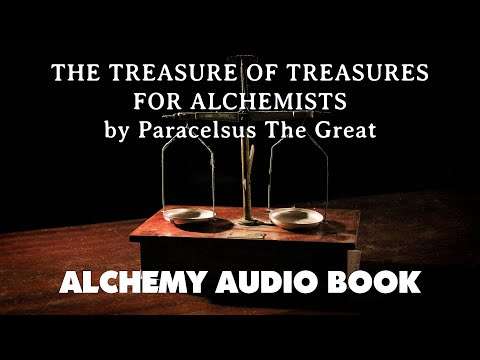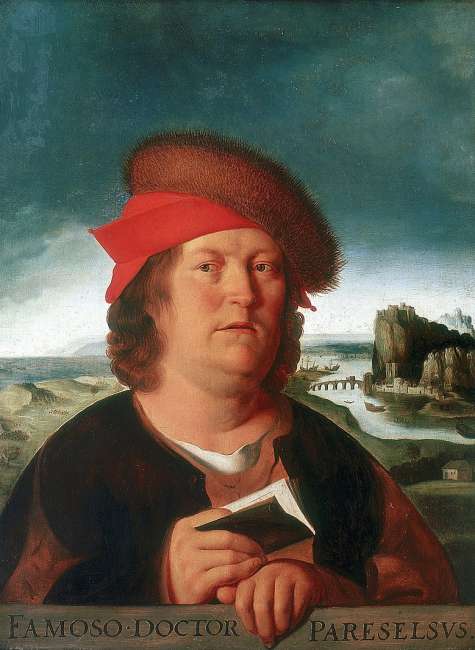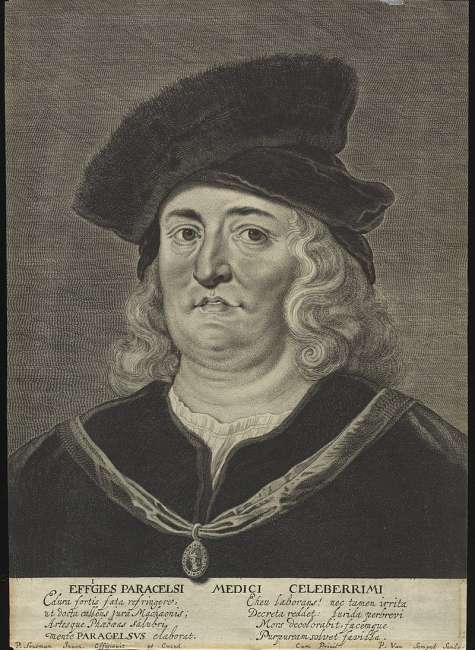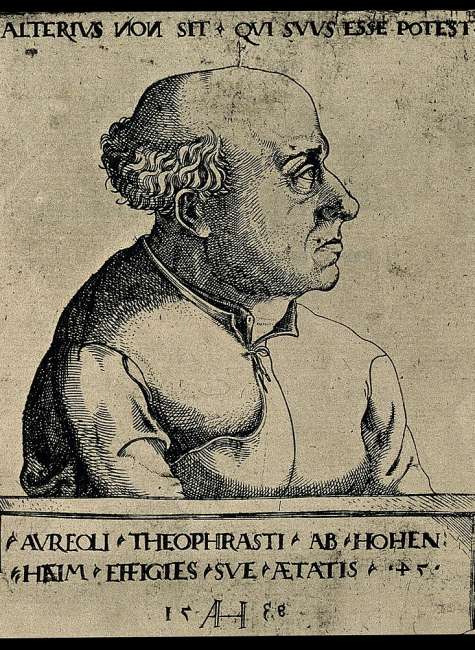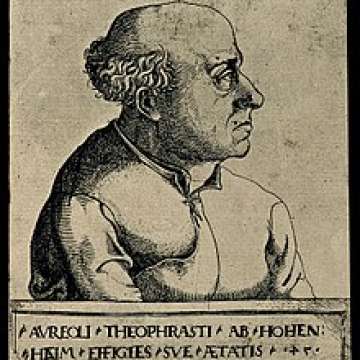

Paracelsus (1493-1541)
All things are poisons, for there is nothing without poisonous qualities. It is only the dose which makes a thing poison.
Paracelsus, born Theophrastus von Hohenheim full name Philippus Aureolus Theophrastus Bombastus von Hohenheim, was a Swiss physician, alchemist, lay theologian, and philosopher of the German Renaissance.
He was a pioneer in several aspects of the "medical revolution" of the Renaissance, emphasizing the value of observation in combination with received wisdom. He is credited as the "father of toxicology". Paracelsus also had a substantial impact as a prophet or diviner, his "Prognostications" being studied by Rosicrucians in the 1600s. Paracelsianism is the early modern medical movement inspired by the study of his works.
Biography
Paracelsus was born in Egg, a village close to the Etzel Pass in Einsiedeln, Schwyz. He was born in a house right next to a bridge across the Sihl river known as Teufelsbrücke. The historical house, dated to the 14th century, was destroyed in 1814. The Restaurant Krone now stands in its place. His father Wilhelm d. 1534 was a chemist and physician, an illegitimate descendant of the Swabian noble family Bombast von Hohenheim. It has been suggested that Paracelsus's descent from the Bombast of Hohenheim family was his own invention, and that his father was in fact called Höhener and was a native of Gais in Appenzell, but it is plausible that Wilhelm was the illegitimate son of Georg Bombast von Hohenheim 1453–1499, commander of the Order of Saint John in Rohrdorf.
Paracelsus's mother was probably a native of the Einsiedeln region and a bondswoman of Einsiedeln Abbey, who before her marriage worked as superintendent in the abbey's hospital. Paracelsus in his writings repeatedly made references to his rustic origins and occasionally used Eremita from the name of Einsiedeln, meaning "hermitage" as part of his name.
Paracelsus' mother probably died in 1502, after which Paracelsus's father moved to Villach, Carinthia, where he worked as a physician, attending to the medical needs of the pilgrims and inhabitants of the cloister. Paracelsus was educated by his father in botany, medicine, mineralogy, mining, and natural philosophy. He also received a profound humanistic and theological education from local clerics and the convent school of St. Paul's Abbey in the Lavanttal. He specifically accounts for being tutored by Johannes Trithemius, abbot of Sponheim. At the age of 16 he started studying medicine at the University of Basel, later moving to Vienna. He gained his medical doctorate from the University of Ferrara in 1515 or 1516.
Early career
"Paracelsus sought a universal knowledge that was not found in books or faculities" thus, between 1517 and 1524, he embarked on a series of extensive travels around Europe. His wanderings led him from Italy, France, to Spain, Portugal, to England, Germany, Scandinavia Poland, Russia, Hungary, Croatia, to Rhodes, Constantinople, and possibly even Egypt. During this period of travel, Paracelsus enlisted as an army surgeon and was involved in the wars waged by Venice, Holland, Denmark, and the Tartars. Then Paracelsus returned home from his travels in 1524.

"After visiting his father at Villach and finding no local opportunity to practice, he settled in Salzburg", as a physician, in 1524 and remained there until 1527. "Since 1519/20 he had been working on his first medical writings, and he now completed Elf Traktat and Volumen medicinae Paramirum, which describe eleven common maladies and their treatment, and his early medical principles". During his return to Villach and working on his first medical writings, "he contemplated many fundamental issues such as the meaning of life and death, health, the causes of disease internal imbalances or external forces, the place of humans in the world and in the universe, and the relationship between humans including himself and God".
Basel 1526–1528
In 1526, he bought the rights of citizenship in Strasbourg to establish his own practice. But soon after he was called to Basel to the sickbed of printer Johann Frobenius, reportedly curing him. During that time, the Dutch Renaissance humanist Erasmus of Rotterdam, also at the University of Basel, witnessed the medical skills of Paracelsus, and the two scholars initiated a letter dialogue on medical and theological subjects.
I cannot offer thee
A reward equal to thy art and knowledge
I surely offer thee a grateful soul
Thou hast recalled from the shades of Frobenius who is my other half:
If thou restorest me also thou restorest each through the other.
In 1527, Paracelsus was a licensed physician in Basel with the privilege of lecturing at the University of Basel. Basel at the time was a center of Renaissance humanism, and Paracelsus here came into contact with Erasmus of Rotterdam, Wolfgang Lachner, and Johannes Oekolampad. Paracelsus's lectures at Basel university unusually were held in German, not Latin. He stated that he wanted his lectures to be available to everyone. He also published harsh criticism of the Basel physicians and apothecaries, creating political turmoil to the point of his life being threatened. In a display of his contempt for conventional medicine, Paracelsus publicly burned editions of the works of Galen and Avicenna. He was prone to many outbursts of abusive language, abhorred untested theory, and ridiculed anybody who placed more importance on titles than practice 'if disease put us to the test, all our splendor, title, ring, and name will be as much help as a horse's tail'. During his time as a professor at the University of Basel, he invited barber-surgeons, alchemists, apothecaries, and others lacking academic background to serve as examples of his belief that only those who practiced an art knew it: 'The patients are your textbook, the sickbed is your study.' Paracelsus was compared with Martin Luther because of his openly defiant acts against the existing authorities in medicine. Paracelsus rejected that comparison. Famously Paracelsus said, "I leave it to Luther to defend what he says and I will be responsible for what I say. That which you wish to Luther, you wish also to me: You wish us both in the fire." Being threatened with an unwinnable lawsuit, he left Basel for Alsace in February 1528.
Later career
In Alsace, Paracelsus took up the life of an itinerant physician once again. After staying in Colmar with Lorenz Fries , and briefly in Esslingen, he moved to Nuremberg in 1529. His reputation went before him, and the medical professionals excluded him from practicing.
The name Paracelsus is first attested in this year, used as a pseudonym for the publication of a Practica of political-astrological character in Nuremberg. Pagel 1982 supposes that the name was intended for use as the author of non-medical works, while his real name Theophrastus von Hohenheim was used for medical publications. The first use of Doctor Paracelsus in a medical publication was in 1536, as the author of the Grosse Wundartznei. The name is usually interpreted as either a latinization of Hohenheim based on celsus "high, tall" or as the claim of "surpassing Celsus". It has been argued that the name was not the invention of Paracelsus himself, who would have been opposed to the humanistic fashion of Latinized names, but was given to him by his circle of friends in Colmar in 1528. It is difficult to interpret but does appear to express the "paradoxical" character of the man, the prefix "para" suggestively being echoed in the titles of Paracelsus's main philosophical works, Paragranum and Paramirum as it were "beyond the grain" and "beyond wonder"; a paramiric treatise having been announced by Paracelsus as early as 1520.

The great medical problem of this period was syphilis, then-recently imported from the West Indies, and running rampant as a pandemic completely untreated. Paracelsus vigorously attacked the treatment with guaiac wood as useless, a scam perpetrated by the Fugger of Augsburg as the main importers of the wood in two publications on the topic. When his further stay in Nuremberg had become impossible, he retired to Beratzhausen, hoping to return to Nuremberg and publish an extended treatise on the "French sickness", but its publication was prohibited by a decree of the Leipzig faculty of medicine, represented by Heinrich Stromer, a close friend and associate of the Fugger family.
In Beratzhausen, Paracelsus prepared Paragranum, his main work on medical philosophy, completed 1530. Moving on to St. Gall, he then completed his Opus Paramirum in 1531, which he dedicated to Joachim Vadian. From St. Gall, he moved on to the land of Appenzell, where he was active as lay preacher and healer among the peasantry. In the same year, he also visited the mines in Schwaz and Hall in Tyrol, working on his book on miners' diseases. He moved on to Innsbruck, where he was once again barred from practicing. He passed Sterzing in 1534, moving on to Meran, Veltlin, and St. Moritz, which he praised for its healing springs. In Meran, he also came in contact with the socio-religious programs of the anabaptists. He visited Pfäfers Abbey, dedicating a separate pamphlet to its baths 1535. He passed Kempten, Memmingen, Ulm, and Augsburg in 1536. He finally managed to publish his Die grosse Wundartznei "The Great Surgery Book", printed in Ulm, Augsburg, and Frankfurt in this year.

His Astronomia magna also known as Philosophia sagax was completed in 1537, but published only in 1571. It is a treatise on hermeticism, astrology, divination, theology, and demonology, and it laid the basis of Paracelsus's later fame as a "prophet". His motto Alterius non sit qui suus esse potest "Let no man belong to another who can belong to himself" is inscribed on a 1538 portrait by Augustin Hirschvogel.
Death and legacy
In 1541, Paracelsus moved to Salzburg, probably on the invitation of Ernest of Bavaria, where he died on 24 September. He was buried in St Sebastian's cemetery in Salzburg. His remains were relocated inside St Sebastian's church in 1752.
After his death, the movement of Paracelsianism was seized upon by many wishing to subvert the traditional Galenic physics, and his therapies became more widely known and used. His autographs have been lost, but many of his works which remained unpublished during his lifetime were edited by Johannes Huser of Basel during 1589–1591. His works were frequently reprinted and widely read during the late 16th to early 17th century, and although his "occult" reputation remained controversial, his medical contributions were universally recognized, with e.g. a 1618 pharmacopeia by the Royal College of Physicians in London including "Paracelsian" remedies.
The late 16th century also saw substantial production of Pseudo-Paracelsian writing, especially letters attributed to Paracelsus, to the point where biographers find it impossible to draw a clear line between genuine tradition and legend.
Philosophy
As a physician of the early 16th century, Paracelsus held a natural affinity with the Hermetic, Neoplatonic, and Pythagorean philosophies central to the Renaissance, a world-view exemplified by Marsilio Ficino and Pico della Mirandola. Astrology was a very important part of Paracelsus's medicine and he was a practicing astrologer – as were many of the university-trained physicians working at that time in Europe. Paracelsus devoted several sections in his writings to the construction of astrological talismans for curing disease. He also invented an alphabet called the Alphabet of the Magi, for engraving angelic names upon talismans. Paracelsus largely rejected the philosophies of Aristotle and Galen, as well as the theory of humours. Although he did accept the concept of the four elements as water, air, fire, and earth, he saw them merely as a foundation for other properties on which to build.
He often viewed fire as the Firmament that sat between air and water in the heavens. Paracelsus often uses an egg to help describe the elements. In his early model he claimed that air surrounded the world like an egg shell. The next element in his egg analogy is fire. Fire has a type of chaos to it that allows it to hold up earth and water, and this makes it like the egg white beneath the shell. The earth and water make up a globe which, in terms of the egg, is the yolk. In De Meteoris, Paracelsus says that the firmament is the heavens. He changed the way he thought of the elements as his life went on.
Contributions to medicine
Chemistry
Paracelsus was one of the first medical professors to recognize that physicians required a solid academic knowledge in the natural sciences, especially chemistry. Paracelsus pioneered the use of chemicals and minerals in medicine. From his study of the elements, Paracelsus adopted the idea of tripartite alternatives to explain the nature of medicine, composed of a combustible element sulphur, a fluid and changeable element mercury, and a solid, permanent element salt. The first mention of the mercury-sulphur-salt model was in the Opus paramirum dating to about 1530. Paracelsus believed that the principles sulphur, mercury, and salt contained the poisons contributing to all diseases. He saw each disease as having three separate cures depending on how it was afflicted, either being caused by the poisoning of sulphur, mercury, or salt. Paracelsus drew the importance of sulphur, salt, and mercury from medieval alchemy, where they all occupied a prominent place. He demonstrated his theory by burning a piece of wood. The fire was the work of sulphur, the smoke was mercury, and the residual ash was salt. Paracelsus also believed that mercury, sulphur, and salt provided a good explanation for the nature of medicine because each of these properties existed in many physical forms. The tria prima also defined the human identity. Salt represented the body; mercury represented the spirit imagination, moral judgment, and the higher mental faculties; sulphur represented the soul the emotions and desires. By understanding the chemical nature of the tria prima, a physician could discover the means of curing disease. With every disease, the symptoms depended on which of the three principals caused the ailment. Paracelsus theorized that materials which are poisonous in large doses may be curative in small doses; he demonstrated this with the examples of magnetism and static electricity, wherein a small magnet can attract much larger metals.
He was probably the first to give the element zinc zincum its modern name, in about 1526, likely based on the sharp pointed appearance of its crystals after smelting zinke translating to "pointed" in German. Paracelsus invented chemical therapy, chemical urinalysis, and suggested a biochemical theory of digestion. Paracelsus used chemistry and chemical analogies in his teachings to medical students and to the medical establishment, many of whom found them objectionable.
Paracelsus in the beginning of the sixteenth century had unknowingly observed hydrogen as he noted that in reaction when acids attack metals, gas was a by-product. Later, Théodore de Mayerne repeated Paracelsus’s experiment in 1650 and found that the gas was flammable. However neither Paracelsus nor de Mayerne proposed that hydrogen could be a new element.
Hermeticism
His hermetical beliefs were that sickness and health in the body relied upon the harmony of humans microcosm and nature macrocosm. He took a different approach from those before him, using this analogy not in the manner of soul-purification but in the manner that humans must have certain balances of minerals in their bodies, and that certain illnesses of the body had chemical remedies that could cure them. As a result of this hermetical idea of harmony, the universe's macrocosm was represented in every person as a microcosm. An example of this correspondence is the doctrine of signatures used to identify curative powers of plants. If a plant looked like a part of the body, then this signified its ability to cure this given anatomy. Therefore, the root of the orchid looks like a testicle and can therefore heal any testicle-associated illness. Paracelsus mobilized the microcosm-macrocosm theory to demonstrate the analogy between the aspirations to salvation and health. As humans must ward off the influence of evil spirits with morality, they must also ward off diseases with good health.

Paracelsus believed that true anatomy could only be understood once the nourishment for each part of the body was discovered. He believed that one must therefore know the influence of the stars on these particular body parts. Diseases were caused by poisons brought from the stars. However, 'poisons' were not necessarily something negative, in part because related substances interacted, but also because only the dose determined if a substance was poisonous or not. Paracelsus claimed the complete opposite of Galen, in that like cures like. If a star or poison caused a disease, then it must be countered by another star or poison. Because everything in the universe was interrelated, beneficial medical substances could be found in herbs, minerals, and various chemical combinations thereof. Paracelsus viewed the universe as one coherent organism that is pervaded by a uniting lifegiving spirit, and this in its entirety, humans included, was 'God'. His beliefs put him at odds with the Catholic Church, for which there necessarily had to be a difference between the creator and the created.
Paracelsus also described four elemental beings, each corresponding to one of the four elements: Salamanders, which correspond to fire; Gnomes, corresponding to earth; Undines, corresponding to water; and Sylphs, corresponding to air.
Discoveries and treatments
Paracelsus is frequently credited with reintroducing opium to Western Europe during the German Renaissance. He extolled the benefits of opium, and of a pill he called laudanum, which has frequently been asserted by others to have been an opium tincture. Paracelsus did not leave a complete recipe, and the known ingredients differ considerably from 17th-century laudanum.
Paracelsus invented, or at least named a sort of liniment, opodeldoc, a mixture of soap in alcohol, to which camphor and sometimes a number of herbal essences, most notably wormwood, were added. Paracelsus's recipe forms the basis for most later versions of liniment.
His work Die große Wundarzney is a forerunner of antisepsis. This specific empirical knowledge originated from his personal experiences as an army physician in the Venetian wars. Paracelsus demanded that the application of cow dung, feathers and other noxious concoctions to wounds be surrendered in favor of keeping the wounds clean, stating, "If you prevent infection, Nature will heal the wound all by herself." During his time as a military surgeon, Paracelsus was exposed to the crudity of medical knowledge at the time, when doctors believed that infection was a natural part of the healing process. He advocated for cleanliness and protection of wounds, as well as the regulation of diet. Popular ideas of the time opposed these theories and suggested sewing or plastering wounds. Historians of syphilitic disease credit Paracelsus with the recognition of the inherited character of syphilis. In his first medical publication, a short pamphlet on syphilis treatment that was also the most comprehensive clinical description the period ever produced, he wrote a clinical description of syphilis in which he maintained that it could be treated by carefully measured doses of mercury. Similarly, he was the first to discover that the disease could only be contracted by contact.
Hippocrates put forward the theory that illness was caused by an imbalance of the four humors: blood, phlegm, black bile and yellow bile. These ideas were further developed by Galen into an extremely influential and highly persistent set of medical beliefs that were to last until the mid-1850s. Contrarily, Paracelsus believed in three humors: salt representing stability, sulphur representing combustibility, and mercury representing liquidity; he defined disease as a separation of one humor from the other two. He believed that body organs functioned alchemically, that is, they separated pure from impure. The dominant medical treatments in Paracelsus's time were specific diets to help in the "cleansing of the putrefied juices" combined with purging and bloodletting to restore the balance of the four humors. Paracelsus supplemented and challenged this view with his beliefs that illness was the result of the body being attacked by outside agents. He objected to excessive bloodletting, saying that the process disturbed the harmony of the system, and that blood could not be purified by lessening its quantity. Paracelsus believed that fasting helped enable the body to heal itself. 'Fasting is the greatest remedy, the physician within.'
Paracelsus gave birth to clinical diagnosis and the administration of highly specific medicines. This was uncommon for a period heavily exposed to cure-all remedies. The germ theory was anticipated by him as he proposed that diseases were entities in themselves, rather than states of being. Paracelsus first introduced the black hellebore to European pharmacology and prescribed the correct dosage to alleviate certain forms of arteriosclerosis. Lastly, he recommended the use of iron for "poor blood" and is credited with the creation of the terms "chemistry," "gas," and "alcohol".
During Paracelsus's lifetime and after his death, he was often celebrated as a wonder healer and investigator of those folk medicines that were rejected by the fathers of medicine e.g. Galen, Avicenna. It was believed that he had success with his own remedies curing the plague, according to those that revered him. Since effective medicines for serious infectious diseases weren't invented before the 19th century, Paracelsus came up with many prescriptions and concoctions on his own. For infectious diseases with fever, it was common to prescribe diaphoretics and tonics that at least gave temporary relief. Also many of his remedies contained the famed "theriac", a preparation derived from oriental medicine sometimes containing opium. The following prescription by Paracelsus was dedicated to the village of Sterzing:
eines guten gebranten weins...ein moß, (Medicinal brandy)
eines guten tiriaks zwölf lot, (Theriac)
myrrhen vier lot, (Myrrh)
wurzen von roßhuf sechs lot, (Tussilago sp.)
sperma ceti,
terrae sigillatae ietlichs ein lot, (Medicinal earth)
schwalbenwurz zwei lot, (Vincetoxicum sp.)
diptan, bibernel, baldrianwurzel ietlichs ein lot (Dictamnus albus, Valerian, Pimpinella)
gaffer ein quint. (Camphor)
Dise ding alle durch einander gemischet, in eine sauberes glas wol gemacht, auf acht tag in der sonne stehen lassen, nachfolgents dem kranken ein halben löffel eingeben... (Mix all these things together, put them into a clean glass, let them stand in the sun for eight days, then give the sick person half a spoonful...)
One of his most overlooked achievements was the systematic study of minerals and the curative powers of alpine mineral springs. His countless wanderings also brought him deep into many areas of the Alps, where such therapies were already practiced on a less common scale than today. Paracelsus's major work On the Miners' Sickness and Other Diseases of Miners documented the occupational hazards of metalworking including treatment and prevention strategies.
Toxicology
Paracelsus extended his interest in chemistry and biology to what is now considered toxicology. He clearly expounded the concept of dose response in his Third Defense, where he stated that "Solely the dose determines that a thing is not a poison." Sola dosis facit venenum "Only the dose makes the poison" This was used to defend his use of inorganic substances in medicine as outsiders frequently criticized Paracelsus's chemical agents as too toxic to be used as therapeutic agents. His belief that diseases locate in a specific organ was extended to inclusion of target organ toxicity; that is, there is a specific site in the body where a chemical will exert its greatest effect. Paracelsus also encouraged using experimental animals to study both beneficial and toxic chemical effects.
Psychosomatism
In his work Von den Krankeiten Paracelsus writes: "Thus, the cause of the disease chorea lasciva is a mere opinion and idea, assumed by imagination, affecting those who believe in such a thing. This opinion and idea are the origin of the disease both in children and adults. In children the case is also imagination, based not on thinking but on perceiving, because they have heard or seen something. The reason is this: their sight and hearing are so strong that unconsciously they have fantasies about what they have seen or heard." Paracelsus called for the humane treatment of the mentally ill as he saw them not to be possessed by evil spirits, but merely 'brothers' ensnared in a treatable malady."
Reception and legacy
Portraits
The oldest surviving portrait of Paracelsus is a woodcut by Augustin Hirschvogel, published in 1538, still during Paracelsus's lifetime. A still older painting by Quentin Matsys has been lost, but at least three 17th-century copies survive, one by an anonymous Flemish artist, kept in the Louvre, one by Peter Paul Rubens, kept in Brussels, and one by a student of Rubens, now kept in Uppsala. Another portrait by Hirschvogel, dated 1540, claims to show Paracelsus "at the age of 47" sue aetatis 47, i.e. less than a year before his death. In this portrait, Paracelsus is shown as holding his sword, gripping the spherical pommel with the right hand. Above and below the image are the mottos Alterius non sit qui suus esse potest "Let no man belong to another who can belong to himself" and Omne donum perfectum a Deo, inperfectum a Diabolo "All perfect gifts are from God, from the Devil"; later portraits give a German rendition in two rhyming couplets Eines andern Knecht soll Niemand sein / der für sich bleiben kann allein /all gute Gaben sint von Got / des Teufels aber sein Spot. Posthumous portraits of Paracelsus, made for publications of his books during the second half of the 16th century, often show him in the same pose, holding his sword by its pommel.

The so-called "Rosicrucian portrait", published with Philosophiae magnae Paracelsi Heirs of Arnold Birckmann, Cologne, 1567, is closely based on the 1540 portrait by Hirschvogel but mirrored, so that now Paracelsus's left hand rests on the sword pommel, adding a variety of additional elements: the pommel of the sword is inscribed by Azoth, and next to the figure of Paracelsus, the Bombast von Hohenheim arms are shown with an additional border of eight crosses patty. Shown in the background are "early Rosicrucian symbols", including the head of a child protruding from the ground indicating rebirth. The portrait is possibly a work by Frans Hogenberg, acting under the directions of Theodor Birckmann 1531/33–1586.
Paracelsianism and Rosicrucianism
Paracelsus was especially venerated by German Rosicrucians, who regarded him as a prophet, and developed a field of systematic study of his writings, which is sometimes called "Paracelsianism", or more rarely "Paracelsism". Francis Bacon warned against Paracelsus and the Rosicrucians, judging that "the ancient opinion that man was microcosmus" had been "fantastically strained by Paracelsus and the alchemists".
"Paracelsism" also produced the first complete edition of Paracelsus's works. Johannes Huser of Basel c. 1545–1604 gathered autographs and manuscript copies, and prepared an edition in ten volumes during 1589–1591.

The prophecies contained in Paracelsus's works on astrology and divination began to be separately edited as Prognosticon Theophrasti Paracelsi in the early 17th century. His prediction of a "great calamity just beginning" indicating the End Times was later associated with the Thirty Years' War, and the identification of Gustavus Adolphus of Sweden as the "Lion from the North" is based in one of Paracelsus's "prognostications" referencing Jeremiah 5:6.
Carl Gustav Jung studied Paracelsus. Two essays on Paracelsus, one delivered in the house in which Paracelsus was born at Einsiedeln in June 1929, the other to commemorate the 400th anniversary of Paracelsus's death in 1941 at Zurich.
In literature and drama
A number of fictionalised depictions of Paracelsus have been published in modern literature. The first presentation of Paracelsus's life in the form of a historical novel was published in 1830 by Dioclès Fabre d'Olivet 1811–1848, son of Antoine Fabre d'Olivet, Robert Browning wrote a long poem based on the life of Paracelsus, entitled Paracelsus, published 1835. Meinrad Lienert in 1915 published a tale which he attributed to Gall Morel about Paracelsus's sword. the Fullmetal Alchemist character Von Hohenheim full name Theophrastus Bombastus Von Hohenheim is named after Paracelsus.

Arthur Schnitzler wrote a verse play Paracelsus in 1899. Erwin Guido Kolbenheyer wrote a novel trilogy Paracelsus-Trilogie, published during 1917–26. Martha Sills-Fuchs 1896–1987 wrote three völkisch plays with Paracelsus as the main character during 1936–1939 in which Paracelsus is depicted as the prophetic healer of the German people. The German drama film Paracelsus was made in 1943, directed by Georg Wilhelm Pabst. Also in 1943, Richard Billinger wrote a play Paracelsus for the Salzburg Festival.
Mika Waltari's Mikael Karvajalka 1948 has a scene fictionalising Paracelsus's acquisition of his legendary sword. Paracelsus is the main character of Jorge Luis Borges's short story La rosa de Paracelso anthologized in Shakespeare's Memory, 1983. An alchemist based on him named Van Hohenheim is one of the main characters of the manga Fullmetal Alchemist. The Rose of Paracelsus: On Secrets and Sacraments, borrowing from Jorge Luis Borges, is also a novel by William Leonard Pickard.
Works
German Wikisource has original text related to this article: Paracelsus
Because of the work of Karl Widemann, who copied over 30 years the work of Paracelsus, many unpublished works survived.
- De gradibus et compositionibus receptorum naturalim, 1526.
- Vom Holtz Guaico on guaiacum, 1529.
- Practica, gemacht auff Europen 1529.
- Von der Frantzösischen kranckheit Drey Bücher on syphilis, 1530.
- Von den wunderbarlichen zeychen, so in vier jaren einander nach im Hymmelgewelcke und Luft ersehen 1534
- Von der Bergsucht oder Bergkranckheiten on miners' diseases, 1534.
- Vonn dem Bad Pfeffers in Oberschwytz gelegen Pfäfers baths, 1535.
- Praktica Teutsch auff das 1535 Jar 1535
- Die große Wundarzney "Great Book of Surgery", Ulm 1536 Hans Varnier; Augsburg 1536 Haynrich Stayner =Steyner, Frankfurt 1536 Georg Raben/ Weygand Hanen.
- Prognosticatio Ad Vigesimum Quartum annum duratura 1536
- Wundt unnd Leibartznei. Frankfurt: Christian Egenolff, 1549 reprinted 1555, 1561.
- Das Buch Paramirum, Mulhouse: Peter Schmid, 1562.
- Aureoli Theophrasti Paracelsi schreiben Von Tartarjschen kranckheiten, nach dem alten nammen, Vom grieß sand vnnd stein, Basel, c. 1563.
- Das Buch Paragranvm Avreoli Theophrasti Paracelsi : Darinnen die vier Columnae, als da ist, Philosophia, Astronomia, Alchimia, vnnd Virtus, auff welche Theophrasti Medicin fundirt ist, tractirt werden, Frankfurt, 1565.
- Opvs Chyrvrgicvm, Frankfurt, 1565.
- Ex Libro de Nymphis, Sylvanis, Pygmaeis, Salamandris, et Gigantibus etc. Nissae Silesiorum, Excudebat Ioannes Cruciger 1566
- Von den Krankheiten so die Vernunfft Berauben. Basel, 1567.
- Philosophia magna, tractus aliquot, Cöln, 1567.
- Philosophiae et Medicinae utriusque compendium, Basel, 1568.
- Neun Bücher Archidoxis. Translated into Latin by Adam Schröter. Kraków: Maciej Wirzbięta, 1569.
- Zwölff Bücher, darin alle gehaimnüß der natur eröffnet, 1570
- Astronomia magna: oder Die gantze Philosophia sagax der grossen und kleinen Welt , Frankfurt, 1571.
- De natura rerum libri septem : Opuscula verè aurea ; Ex Germanica lingua in Latinam translata per M. Georgium Forbergium Mysium philosophiae ac medicinae studiosum, 1573.
- De Peste, Strasbourg: Michael Toxites, Bey Niclauss Wyriot, 1574.
- Volumen Paramirum, Strasbourg: Christian Mülller, 1575.
- Metamorphosis Theophrasti Paracelsi : Dessen werck seinen meister loben wirt, Basel, 1574.
- Von der Wundartzney: Ph. Theophrasti von Hohenheim, beyder Artzney Doctoris, 4 Bücher. Basel: Peter Perna, 1577.
- Kleine Wundartzney. Basel: Peter Perna, 1579.
- Opus Chirurgicum, Bodenstein, Basel, 1581.
- Huser quart edition medicinal and philosophical treatises, ten volmes, Basel, 1589–1591; Huser's edition of Paracelsus' surgical works was published posthumously in Strasbourg, 1605. vol. 1, In diesem Theil werden begriffen die Bücher, welche von Ursprung und herkommen, aller Kranckheiten handeln in Genere. Basel. 1589 urn:nbn:de:bvb:12-bsb00022502-1 vol. 2, Dieser Theil begreifft fürnemlich die Schrifften, inn denen die Fundamenta angezeigt werde, auff welchen die Kunst der rechten Artzney stehe, und auß was Büchern dieselbe gelehrnet werde, Basel. 1589 urn:nbn:de:bvb:12-bsb00022503-6 vol. 3, Inn diesem Theil werden begriffen deren Bücher ettliche, welche von Ursprung, Ursach und Heylung der Kranckheiten handeln in Specie. Basel, 1589 urn:nbn:de:bvb:12-bsb00022504-2 vol. 4, In diesem Theil werden gleichfals, wie im Dritten, solche Bücher begriffen, welche von Ursprung, Ursach unnd Heilung der Kranckheiten in Specie handlen. Basel, 1589 urn:nbn:de:bvb:12-bsb00022505-7 vol. 5, Bücher de Medicina Physica Basel, 1589 urn:nbn:de:bvb:12-bsb10164682-7 vol. 6, In diesem Tomo seind begriffen solche Bücher, in welchen deß mehrer theils von Spagyrischer Bereitung Natürlicher dingen, die Artzney betreffend, gehandelt wirt. Item, ettliche Alchimistische Büchlin, so allein von der Transmutation der Metallen tractiren. Basel, 1590 urn:nbn:de:bvb:12-bsb00022506-2 vol. 7, In diesem Theil sind verfasset die Bücher, in welchen fürnemlich die Kräfft, Tugenden und Eigenschafften Natürlicher dingen, auch derselben Bereitdungen, betreffent die Artzney, beschriben, werden. Basel, 1590 urn:nbn:de:bvb:12-bsb00022507-8 vol. 8, In diesem Tomo welcher der Erste unter den Philosophischen werden solche Bücher begriffen, darinnen fürnemlich die Philosophia de Generationibus & Fructibus quatuor Elementorum beschrieben wirdt. Basel, 1590 urn:nbn:de:bvb:12-bsb00022508-3 vol. 9, Diser Tomus welcher der Ander unter den Philosophischen begreifft solcher Bücher, darinnen allerley Natürlicher und Ubernatürlicher Heymligkeiten Ursprung, Ursach, Wesen und Eigenschafft, gründtlich und warhafftig beschriben werden. Basel, 1591 urn:nbn:de:bvb:12-bsb00022509-3 vol. 10, Dieser Theil welcher der Dritte unter den Philosophischen Schrifften begreifft fürnemlich das treffliche Werck Theophrasti, Philosophia Sagax, oder Astronomia Magna genannt: Sampt ettlichen andern Opusculis, und einem Appendice. Basel, 1591 urn:nbn:de:bvb:12-bsb00022510-5, Frankfurt 1603 Klage Theophrasti Paracelsi, uber seine eigene Discipel, unnd leichtfertige Ertzte, Darbeneben auch unterricht, wie er wil, daß ein rechter Artzt soll geschickt seyn, und seine Chur verrichten, und die Patienten versorgen, etc. ; Auß seinen Büchern auff das kürtzste zusammen gezogen, Wider die Thumkünen selbwachsende, Rhumrhätige, apostatische Ertzte, und leichtfertige Alchymistische Landtstreicher, die sich Paracelsisten nennen ; … jetzo zum ersten also zusammen bracht, und in Truck geben. 1594 urn:nbn:de:bvb:12-bsb00015650-2
- vol. 1, In diesem Theil werden begriffen die Bücher, welche von Ursprung und herkommen, aller Kranckheiten handeln in Genere. Basel. 1589 urn:nbn:de:bvb:12-bsb00022502-1
- vol. 2, Dieser Theil begreifft fürnemlich die Schrifften, inn denen die Fundamenta angezeigt werde, auff welchen die Kunst der rechten Artzney stehe, und auß was Büchern dieselbe gelehrnet werde, Basel. 1589 urn:nbn:de:bvb:12-bsb00022503-6
- vol. 3, Inn diesem Theil werden begriffen deren Bücher ettliche, welche von Ursprung, Ursach und Heylung der Kranckheiten handeln in Specie. Basel, 1589 urn:nbn:de:bvb:12-bsb00022504-2
- vol. 4, In diesem Theil werden gleichfals, wie im Dritten, solche Bücher begriffen, welche von Ursprung, Ursach unnd Heilung der Kranckheiten in Specie handlen. Basel, 1589 urn:nbn:de:bvb:12-bsb00022505-7
- vol. 5, Bücher de Medicina Physica Basel, 1589 urn:nbn:de:bvb:12-bsb10164682-7
- vol. 6, In diesem Tomo seind begriffen solche Bücher, in welchen deß mehrer theils von Spagyrischer Bereitung Natürlicher dingen, die Artzney betreffend, gehandelt wirt. Item, ettliche Alchimistische Büchlin, so allein von der Transmutation der Metallen tractiren. Basel, 1590 urn:nbn:de:bvb:12-bsb00022506-2
- vol. 7, In diesem Theil sind verfasset die Bücher, in welchen fürnemlich die Kräfft, Tugenden und Eigenschafften Natürlicher dingen, auch derselben Bereitdungen, betreffent die Artzney, beschriben, werden. Basel, 1590 urn:nbn:de:bvb:12-bsb00022507-8
- vol. 8, In diesem Tomo welcher der Erste unter den Philosophischen werden solche Bücher begriffen, darinnen fürnemlich die Philosophia de Generationibus & Fructibus quatuor Elementorum beschrieben wirdt. Basel, 1590 urn:nbn:de:bvb:12-bsb00022508-3
- vol. 9, Diser Tomus welcher der Ander unter den Philosophischen begreifft solcher Bücher, darinnen allerley Natürlicher und Ubernatürlicher Heymligkeiten Ursprung, Ursach, Wesen und Eigenschafft, gründtlich und warhafftig beschriben werden. Basel, 1591 urn:nbn:de:bvb:12-bsb00022509-3
- vol. 10, Dieser Theil welcher der Dritte unter den Philosophischen Schrifften begreifft fürnemlich das treffliche Werck Theophrasti, Philosophia Sagax, oder Astronomia Magna genannt: Sampt ettlichen andern Opusculis, und einem Appendice. Basel, 1591 urn:nbn:de:bvb:12-bsb00022510-5, Frankfurt 1603
- Klage Theophrasti Paracelsi, uber seine eigene Discipel, unnd leichtfertige Ertzte, Darbeneben auch unterricht, wie er wil, daß ein rechter Artzt soll geschickt seyn, und seine Chur verrichten, und die Patienten versorgen, etc. ; Auß seinen Büchern auff das kürtzste zusammen gezogen, Wider die Thumkünen selbwachsende, Rhumrhätige, apostatische Ertzte, und leichtfertige Alchymistische Landtstreicher, die sich Paracelsisten nennen ; … jetzo zum ersten also zusammen bracht, und in Truck geben. 1594 urn:nbn:de:bvb:12-bsb00015650-2
- Kleine Wund-Artzney. Straßburg Ledertz, Benedictus Figulus. 1608.
- Opera omnia medico-chemico-chirurgica, Genevae, Vol. 3, 1658.
- Prognosticon Theophrasti Paracelsi, vol. 4 of VI Prognostica Von Verenderung vnd zufaelligem Glueck vnd Vnglueck der ... Potentaten im Roemischen Reich, Auch des Tuercken vnd Pabst ed. Henricus Neotechnus, 1620.
- Paracelsus: Sämtliche Werke: nach der 10 Bändigen Huserschen Gesamtausgabe 1589–1591 zum erstenmal in neuzeitliches deutsch übersetzt, mit Einleitung, Biographie, Literaturangaben und erklärenden Anmerkungen. Edited by Bernhard Aschner. 4 volumes. Jena : G. Fisher, 1926–1932.
- Paracelsus: Sämtliche Werke. Edited by Karl Sudhoff, Wilhelm Matthiessen, and Kurt Goldammer. Part I Medical, scientific, and philosophical writings, 14 volumes Munich and Berlin, 1922–1933. Part II Theological and religious writings, 7 volumes Munich and Wiesbaden, 1923–1986.
- Register zu Sudhoffs Paracelsus-Ausgabe. Allgemeines und Spezialregister: Personen, Orte, Pflanzen, Rezepte, Verweise auf eigene Werke, Bußler, E., 2018, ISBN 978-90-821760-1-8
- Theophrastus Paracelsus: Werke. Edited by Will-Erich Peuckert, 5 vols. Basel and Stuttgart: Schwabe Verlag, 1965–1968.
Selected English translations
- The Hermetic And Alchemical Writings Of Paracelsus, Two Volumes, translated by Arthur Edward Waite, London, 1894. in Google books, see also a revised 2002 edition preview only Partial contents: Coelum Philosophorum; The Book Concerning The Tincture Of The Philosophers; The Treasure of Treasures for Alchemists; The Aurora of the Philosophers; Alchemical Catechism.
- Paracelsus: Essential Readings. Selected and translated by Nicholas Goodrick-Clarke. Berkeley, CA: North Atlantic Books, 1999.
- Paracelsus: His Life and Doctrines. Franz Hartmann, New York: Theosophical Publishing Co., 1918
- Paracelsus Theophrastus Bombastus von Hohenheim, 1494–1541. Essential Theoretical Writings. Edited and translated with a Commentary and Introduction by Andrew Weeks. Leiden/Boston: Brill, 2008, ISBN 978-90-04-15756-9.
- Paracelsus: Selected Writings ed. with an introduction by Jolande Jacobi, trans. Norbert Guterman, New York: Pantheon, 1951 reprinted Princeton 1988
More facts
The Rose of Paracelsus (2013)
Paracelsus (1943)

![The Louvre copy of the lost portrait by Quentin Matsys,[23] source of the iconographic tradition of](https://geniuses.club/public/storage/127/083/027/193/61024cbf378a2.jpg)

















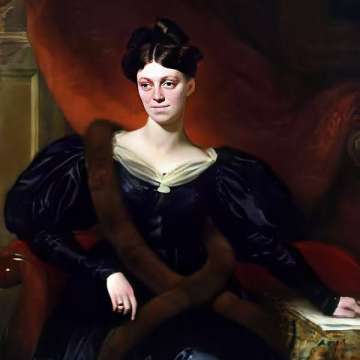






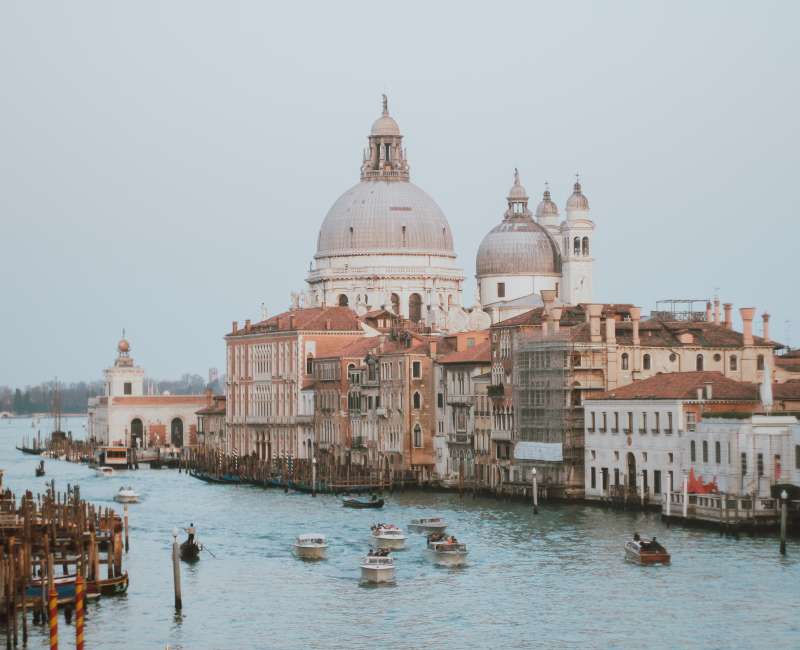
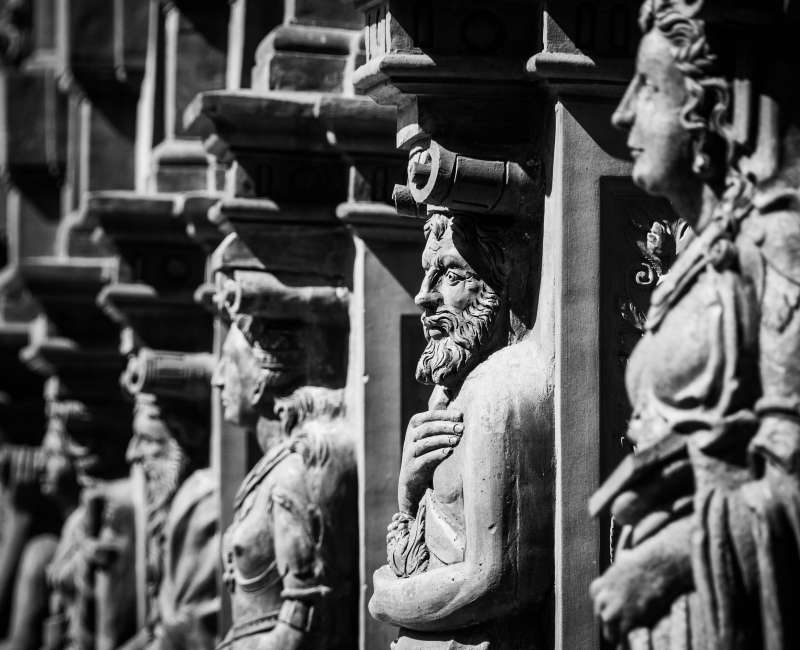
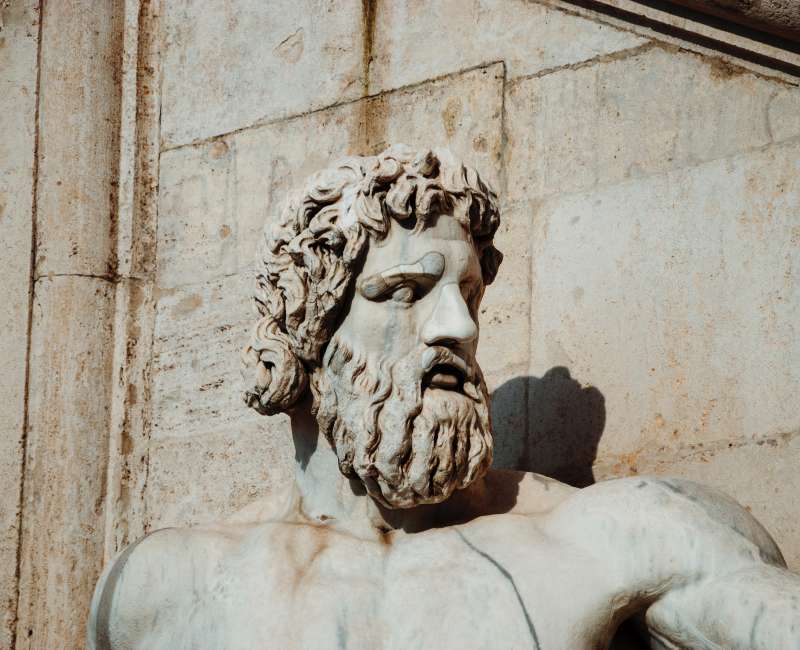

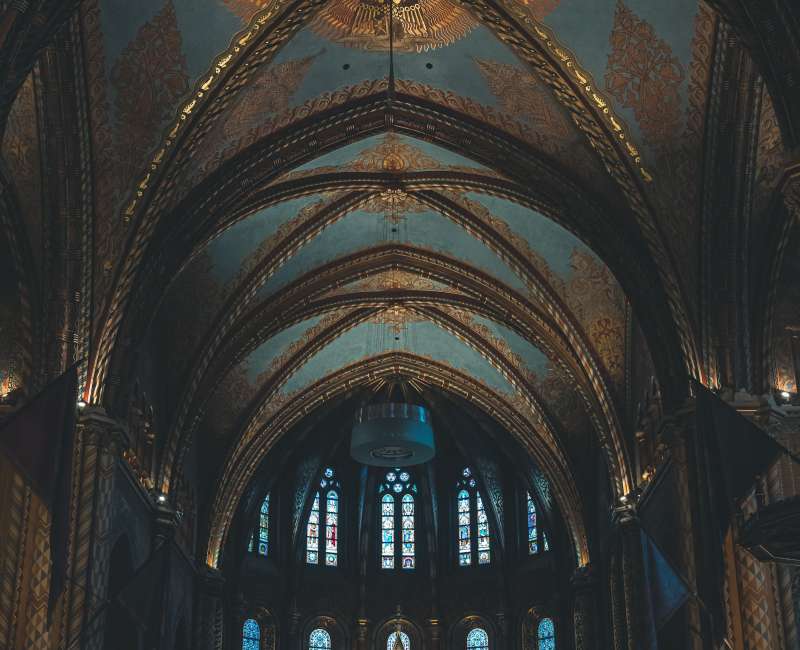
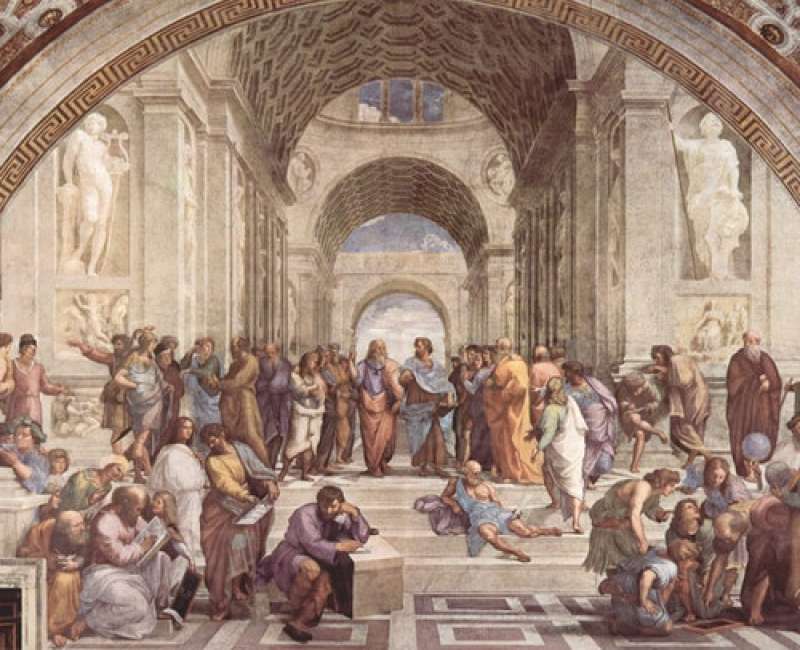
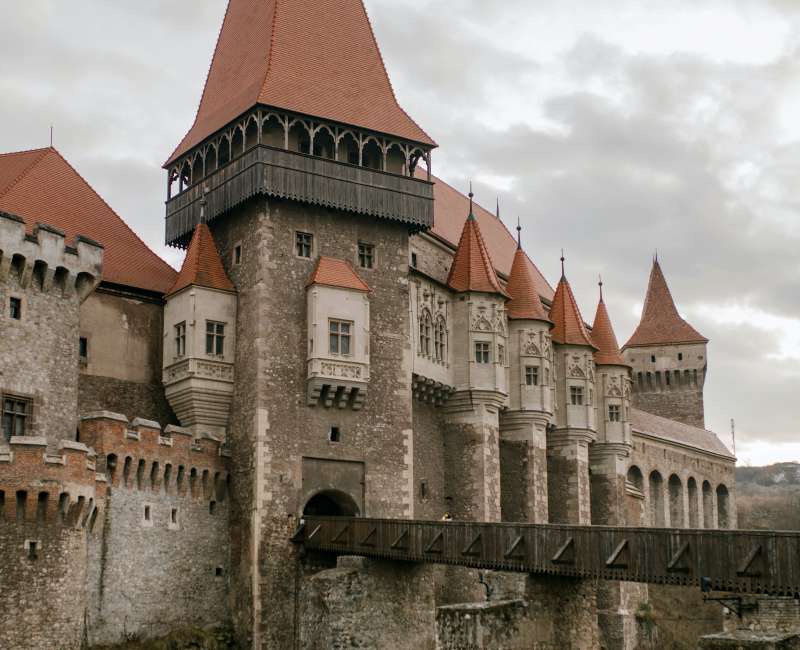
![The Louvre copy of the lost portrait by Quentin Matsys,[23] source of the iconographic tradition of](https://geniuses.club/public/storage/127/083/027/193/480_360_61024cbf378a2.jpg)


